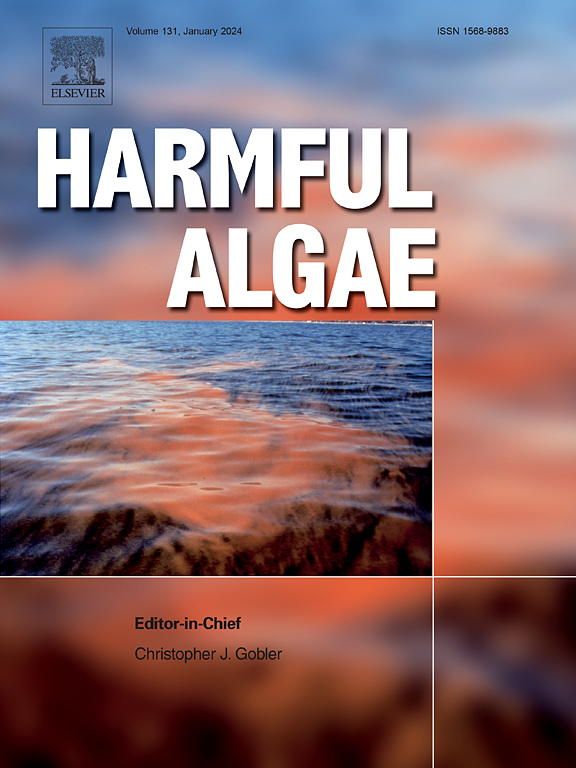Effects of cyanobacterium Phormidium nigroviride K3 on zebrafish embryos and genomic insights into its toxic potential
IF 4.5
1区 生物学
Q1 MARINE & FRESHWATER BIOLOGY
引用次数: 0
Abstract
Cyanobacterial blooms in freshwater systems pose significant environmental and public health risks, largely due to their production of toxic secondary metabolites. This study investigated the effects of Phormidium nigroviride K3 extracts on early zebrafish development, focusing on organismal toxicity and gene expression changes. Acute toxicity was assessed by monitoring developmental deformities and evaluating relative changes in the expression of six genes associated with xenobiotic metabolism, apoptosis, endoplasmic reticulum stress, and endocrine processes. Whole-genome sequencing, in silico genome annotation and mining were conducted to identify biosynthetic gene clusters involved in toxin production. Zebrafish embryos exposed to P. nigroviride K3 extracts developed spinal deformities, pericardial edema, yolk sac edema and reduced eye size, with spinal deformities being the most prevalent malformation (EC50 of 215.6 µg d.w. mL⁻¹). Significant alterations in the expression of genes involved in xenobiotic metabolism were detected, including a dose-dependent 4.6-fold induction of cyp1a1 and a 4.47-fold increase in abcb4 expression at the highest extract concentration. Genome analysis of P. nigroviride K3 revealed 15 biosynthetic gene clusters for secondary metabolites, including a match with the Cylindrospermopsis raciborskii AWT205 cluster, responsible for the cyanotoxin cylindrospermopsin biosynthesis. The LC-MS/MS analysis confirmed the production of cylindrospermopsin in P. nigroviride K3, providing new insights into cyanotoxin biosynthesis in Phormidium species, a genus that has been underexplored in the context of toxin production. These findings expand cyanobacterial genomic databases, enhancing our understanding of cyanobacterial toxic potential. Such knowledge is crucial for predicting and mitigating the risks associated with cyanotoxins in aquatic ecosystems.
蓝藻黑绿磷K3对斑马鱼胚胎的影响及其毒性潜能的基因组学研究
淡水系统中的蓝藻大量繁殖造成重大的环境和公共卫生风险,主要是由于它们产生有毒的次生代谢物。本研究探讨了黑绿磷K3提取物对斑马鱼早期发育的影响,重点关注其机体毒性和基因表达变化。通过监测发育畸形和评估与外源代谢、细胞凋亡、内质网应激和内分泌过程相关的六种基因表达的相对变化来评估急性毒性。进行了全基因组测序、计算机基因组注释和挖掘,以确定参与毒素产生的生物合成基因簇。斑马鱼胚胎暴露于黑草酸K3提取物后,会出现脊柱畸形、心包水肿、卵黄囊水肿和眼睛变小,其中脊柱畸形是最常见的畸形(EC50为215.6µg d.w. mL毒毒毒毒图)。检测到参与外源代谢的基因表达发生了显著变化,包括在最高提取物浓度下cyp1a1的剂量依赖性诱导4.6倍,abcb4的表达增加4.47倍。对P. nigroviride K3的基因组分析发现了15个次生代谢产物的生物合成基因簇,其中包括与cyanotoxin cydrospermopsis raciborskii AWT205基因簇匹配。LC-MS/MS分析证实了P. nigroviride K3中产生圆柱精子素,为紫堇属(Phormidium)的藻毒素生物合成提供了新的见解,这一属在毒素生产方面一直未被充分探索。这些发现扩大了蓝藻基因组数据库,增强了我们对蓝藻毒性潜力的理解。这些知识对于预测和减轻水生生态系统中与蓝藻毒素有关的风险至关重要。
本文章由计算机程序翻译,如有差异,请以英文原文为准。
求助全文
约1分钟内获得全文
求助全文
来源期刊

Harmful Algae
生物-海洋与淡水生物学
CiteScore
12.50
自引率
15.20%
发文量
122
审稿时长
7.5 months
期刊介绍:
This journal provides a forum to promote knowledge of harmful microalgae and macroalgae, including cyanobacteria, as well as monitoring, management and control of these organisms.
 求助内容:
求助内容: 应助结果提醒方式:
应助结果提醒方式:


